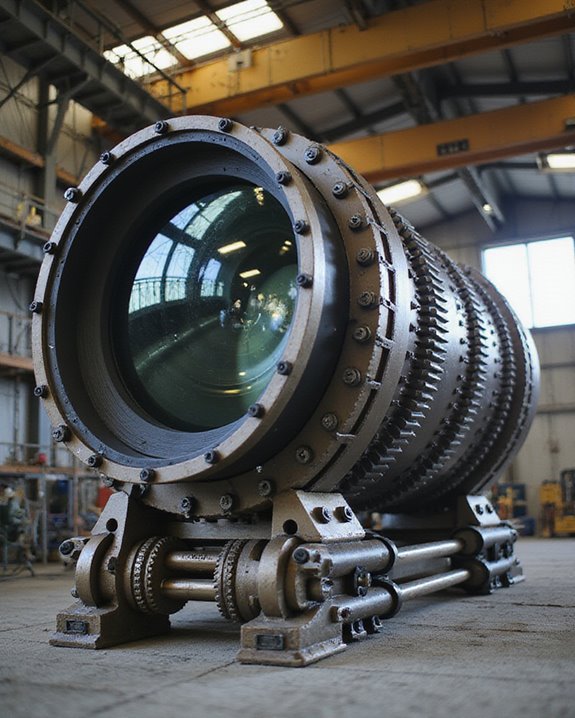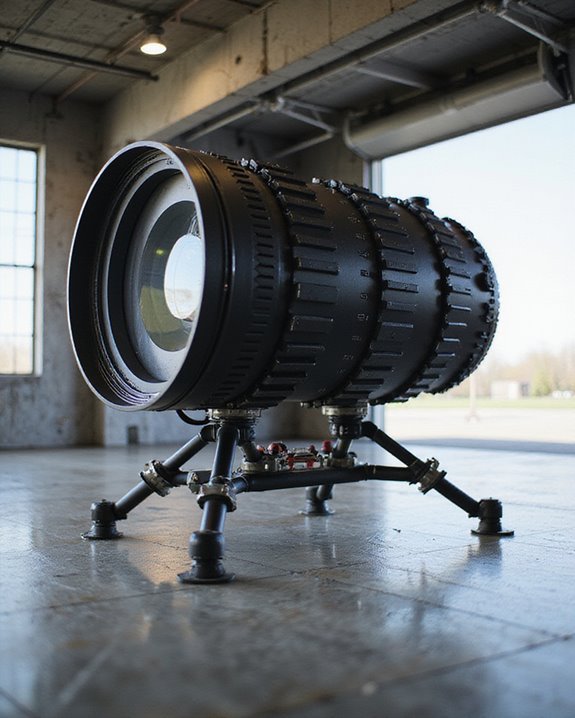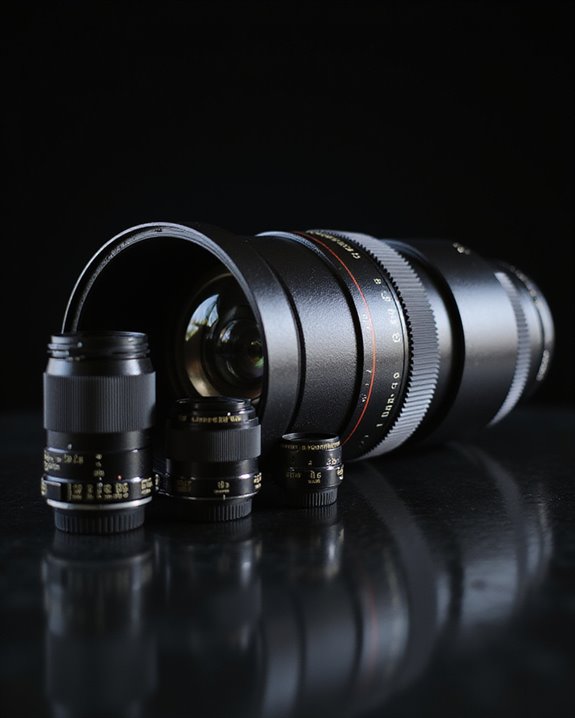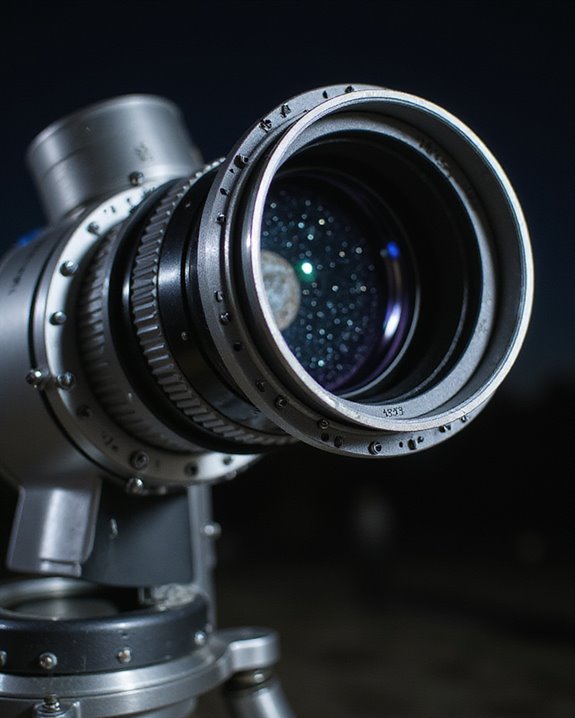The largest camera lens measures 1.57 meters in diameter and forms part of the LSST Camera, which includes three massive lenses and a 3.2-billion-pixel CCD sensor offering a 9.6-square-degree field of view. This lens assembly, housed within a 1.65-meter diameter, 3-meter-long sealed enclosure, supports high-fidelity imaging of faint celestial objects. Its advanced thermal management and precision optics surpass consumer telephoto lenses in size and resolution, enabling extensive astrophysical data capture, with further technical insights available beyond this summary.
Key Takeaways
- The largest camera lens has a diameter of 1.57 meters, making it the world’s biggest high-performance optical lens.
- It is part of the LSST Camera with a 3.2-billion-pixel sensor and three massive lenses for exceptional astronomical imaging.
- The entire camera assembly weighs about 2,800 kilograms and is enclosed in a sealed, refrigerated housing 1.65 meters wide and 3 meters long.
- Designed for the Vera C. Rubin Observatory, it captures up to 15 terabytes of celestial data nightly with a 9.6-square-degree field of view.
- This lens surpasses large telephoto lenses like the Canon EF 1200mm by offering a much wider field and superior deep-sky survey capabilities.
Specifications of the World’s Largest Camera Lens
The world’s largest camera lens, completed in September 2019, exhibits remarkable specifications that position it at the forefront of optical engineering. Integrated within the LSST Camera for the 8.4-meter Simonyi Telescope, this lens measures 1.57 meters in diameter, establishing it as the world’s largest high-performance optical lens. The LSST Camera system comprises three massive lenses, including this principal lens, combined with a 3.2-billion-pixel CCD sensor, enabling exceptional astronomical imaging capabilities. The lens is housed in a sealed, air-tight enclosure measuring 1.65 meters in diameter and 3 meters in length, designed to maintain ideal environmental conditions. The entire camera assembly, incorporating the lens, weighs approximately 2,800 kilograms, a critical factor ensuring mechanical stability and precision during observations. These specifications underscore its unprecedented size and weight within the field of astronomical instrumentation. Ultra-large lenses are essential for capturing distant celestial objects with unparalleled clarity and detail.
Engineering and Construction Challenges

Engineering and construction of the LSST camera’s 1.57-meter lens presented a series of formidable challenges, necessitating a seven-year process conducted within a controlled clean room environment to guarantee optical precision and prevent particulate contamination. The Rubin Observatory, currently under construction, integrated advanced thermal management to dissipate 1,100 watts of heat generated by the camera’s back-end electronics, ensuring stable operational temperatures. The camera’s refrigerated housing required reengineering of its plumbing system to accommodate a fluid swap, emphasizing complexity in cooling integration. Additionally, the six-filter carousel mechanism, essential for rapid filter changes within 2 minutes, underwent rigorous validation using dummy metal disks to simulate weight and reliability. These engineering measures collectively addressed precision, thermal stability, and mechanical reliability critical to the performance of the observatory’s large lenses. Incorporating high-quality precision-ground glass components was vital to achieving the necessary optical accuracy, further complicating the manufacturing process.
Optical Innovations and Performance Features

Optical innovations integrated into large camera lenses greatly enhance their performance capabilities, as demonstrated by the LSST camera’s 1.57-meter lens and Canon’s RF series telephoto lenses. The LSST lens employs a 3.2-billion-pixel CCD sensor with a 9.6-square-degree field of view, enabling detection of faint celestial bodies with exceptional sensitivity. Canon RF telephoto zoom lenses, including the RF 1200mm and RF 800mm, incorporate advanced optical elements such as UD glass for chromatic aberration correction and ASC coatings to suppress flare and ghosting. The RF 1200mm lens achieves a lighter weight and reduced size by repositioning magnifying optics near the lens rear, shortening focal length assembly by 30cm compared to EF models. Fluorine coatings on front elements facilitate dirt removal, maintaining optical clarity during prolonged outdoor use, collectively advancing large lens imaging precision and usability. Additionally, optical glass elements are meticulously engineered to optimize image resolution and minimize distortions across the entire zoom range.
Installation and Operational Environment

Installation of the largest camera lens, integral to the LSST Camera system, is planned for the 8.4-meter Simonyi Telescope situated at the Vera C. Rubin Observatory in Cerro Pachon, Chile. The big lens will be housed within a sealed, refrigerated enclosure measuring 1.65 meters in diameter and 3 meters in length, designed to maintain ideal thermal conditions for its 3.2-billion-pixel CCD sensor. Transportation involves a vibration-isolated shipping container to prevent mechanical shock during transit from San Francisco to Santiago. Operationally, the camera lens will function continuously under the clear, stable night sky conditions characteristic of the Elqui Province, enabling the telescope to capture up to 15 terabytes of imaging data nightly. This environment guarantees high-fidelity monitoring of celestial objects, maximizing the big lens’s performance for extensive southern sky surveys at the Vera C. Rubin Observatory.
Comparison With Other Notable Telephoto Lenses

The LSST camera lens distinguishes itself markedly from other notable telephoto lenses through its exceptional dimensions, weight, and functional capacity tailored for astronomical research. Measuring 1.57 meters in diameter and weighing approximately 2,800 kg, it surpasses the Canon EF 1200mm f/5.6 L USM lens, which, though offering a 1200mm focal length favored by wildlife photographers, provides a limited 2-degree field of view and weighs considerably less. The Canon 5200mm f/14 Tele-Monster lens, at 100 kg, remains far lighter but impractical for handheld use. Compared to lenses like the Leica APO-Telyt-R 1600mm and Sigma 200-500mm f/2.8, the LSST lens’s scale and 9.6 square degrees sky coverage emphasize its unique design for deep-sky surveys rather than conventional terrestrial photography.
Applications and Observational Capabilities

The LSST camera lens demonstrates exceptional observational capabilities through its expansive 9.6 square degree field of view, which enables it to capture an area approximately 38.4 times larger than the full moon’s 0.25 square degrees in a single exposure. This lens is the world’s largest camera lens, optimized for continuous sky monitoring without reliance on manual focus, employing two lenses in its design for enhanced image precision. It effectively detects movements of asteroids, comets, and stars, while identifying stellar brightness variations from novae and supernovae. The system’s sensitivity to faint, slow-moving objects supports searches for distant celestial bodies such as Planet Nine. Generating up to 15 terabytes of data nightly, it provides critical observational inputs for cosmology, transient phenomena, and solar system dynamics research, demonstrating unmatched technical performance.
Frequently Asked Questions
What Is the Biggest Camera Lens?
The biggest camera lens, notable for its lens size and weight records, surpasses historical giants through design innovations. It exemplifies cutting-edge optical engineering, integrating massive dimensions with advanced materials to enhance imaging performance in astronomy.
Why Is F2.8 so Expensive?
Why does an f/2.8 aperture command such a high cost? The aperture cost stems from complex lens manufacturing to maintain optical quality at this challenging fstop value, requiring premium materials and precise engineering, substantially raising production expenses.
Is There a 1000MM Lens?
The existence debate confirms 1000mm lenses do exist, with availability check revealing models like Canon EF 1200mm. Usage examples span wildlife photography, while historical context dates these lenses back to the early 1990s for specialized applications.
What Is the Largest Zoom on a Camera?
The largest zoom on a camera combines Optical Innovations and Digital Enhancements, offering extensive focal ranges ideal for Wildlife Uses and Sports Applications. Such lenses provide versatile, detailed captures, adapting to diverse shooting conditions with precision and clarity.





